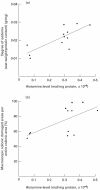Development of dextran sulphate sodium-induced experimental colitis is suppressed in genetically mast cell-deficient Ws/Ws rats
- PMID: 10632661
- PMCID: PMC1905515
- DOI: 10.1046/j.1365-2249.2000.01094.x
Development of dextran sulphate sodium-induced experimental colitis is suppressed in genetically mast cell-deficient Ws/Ws rats
Abstract
Ws/Ws rats have a small deletion of the c-kit gene, and are deficient in both mucosal-type mast cells (MMC) and connective tissue-type mast cells (CTMC). In the present study we investigated the role of intestinal MMC in the development of dextran sulphate sodium (DSS)-induced experimental colitis using Ws/Ws rats. Ws/Ws and control (+/+) rats were given a 3% DSS aqueous solution orally for 10 days, and the subsequent mucosal damage was evaluated macroscopically and histologically. The mucosal myeloperoxidase (MPO) activities and histamine levels were also measured. (i) DSS induced severe oedema and hyperaemia with sporadic erosions in the control (+/+) rats, but these changes were significantly attenuated in the Ws/Ws rats (P < 0.01). (ii) The microscopic mucosal damage score was lower in the Ws/Ws rats than in the control (+/+) rats (P = 0.06). (iii) There were no significant differences in mucosal MPO activity between the Ws/Ws and control (+/+) rats (P = 0.46). (iv) The mucosal histamine levels in the colon were significantly reduced in the Ws/Ws rats compared with the control (+/+) rats (P < 0.05). (v) Significant positive correlations were observed between mucosal histamine levels and the degree of mucosal oedema (calculated as colonic wet weight/protein content) (r = 0.778, P < 0.01), and between histamine levels and the macroscopic damage (r = 0.623, P < 0.05), respectively. (vi) DSS induced a local recruitment of MMC in the colonic mucosa of Ws/Ws rats, and mucosal damage gradually increased in accordance with this MMC recruitment. These results indicate that MMC play an important role in the development of DSS colitis.
Figures





Similar articles
-
Infection of Nippostrongylus brasiliensis induces development of mucosal-type but not connective tissue-type mast cells in genetically mast cell-deficient Ws/Ws rats.Blood. 1993 May 15;81(10):2572-8. Blood. 1993. PMID: 7683922
-
Possible role of mucosal mast cells in the recovery process of colitis induced by dextran sulfate sodium in rats.Int Immunopharmacol. 2003 Apr;3(4):485-91. doi: 10.1016/S1567-5769(02)00299-0. Int Immunopharmacol. 2003. PMID: 12689654
-
Rapid intestinal ischaemia-reperfusion injury is suppressed in genetically mast cell-deficient Ws/Ws rats.Clin Exp Immunol. 1999 Apr;116(1):90-3. doi: 10.1046/j.1365-2249.1999.00851.x. Clin Exp Immunol. 1999. PMID: 10209510 Free PMC article.
-
Effect of toll-like receptor 3 agonist poly I:C on intestinal mucosa and epithelial barrier function in mouse models of acute colitis.World J Gastroenterol. 2017 Feb 14;23(6):999-1009. doi: 10.3748/wjg.v23.i6.999. World J Gastroenterol. 2017. PMID: 28246473 Free PMC article.
-
Mucosal mast cells and the allergic response against nematode parasites.Vet Immunol Immunopathol. 1996 Nov;54(1-4):331-6. doi: 10.1016/s0165-2427(96)05696-6. Vet Immunol Immunopathol. 1996. PMID: 8988878 Review.
Cited by
-
Aggravated mucosal and immune damage in a mouse model of ulcerative colitis with stress.Exp Ther Med. 2019 Mar;17(3):2341-2348. doi: 10.3892/etm.2019.7162. Epub 2019 Jan 9. Exp Ther Med. 2019. PMID: 30783488 Free PMC article.
-
Mitochondrial translocator protein deficiency exacerbates pathology in acute experimental ulcerative colitis.Front Physiol. 2022 Aug 19;13:896951. doi: 10.3389/fphys.2022.896951. eCollection 2022. Front Physiol. 2022. PMID: 36060674 Free PMC article.
-
The role of mast cells in bacterial enteritis.Am J Pathol. 2007 Aug;171(2):399-401. doi: 10.2353/ajpath.2007.070501. Epub 2007 Jun 14. Am J Pathol. 2007. PMID: 17569775 Free PMC article. No abstract available.
-
Inducible MHC class II expression by mast cells supports effector and regulatory T cell activation.J Immunol. 2009 Apr 15;182(8):4686-95. doi: 10.4049/jimmunol.0803180. J Immunol. 2009. PMID: 19342644 Free PMC article.
-
Adverse Food Reactions in Inflammatory Bowel Disease: State of the Art and Future Perspectives.Nutrients. 2024 Jan 25;16(3):351. doi: 10.3390/nu16030351. Nutrients. 2024. PMID: 38337636 Free PMC article. Review.
References
-
- Boros M, Kaszaki J, Nagy S. Histamine release during intestinal ischemia–reperfusion: role of irons and hydrogen peroxide. Circ Shock. 1991;35:174–80. - PubMed
-
- Boros M, Kaszaki J, Nagy S. Oxygen free radical induced histamine release during intestinal ischemia and reperfusion. Eur Surg Res. 1989;21:297–304. - PubMed
-
- Kubes P, Ibbotson G, Russell JM, et al. Role of platelet-activating factor in ischemia/reperfusion induced leukocyte adherence. Am J Physiol. 1990;259:G300–5. - PubMed
-
- McAuley RL, Somers SC. Mast cells in nonspecific ulcerative colitis. Am J Dig Dis. 1961;6:233–6.
MeSH terms
Substances
LinkOut - more resources
Full Text Sources
Other Literature Sources
Medical
Research Materials
Miscellaneous

